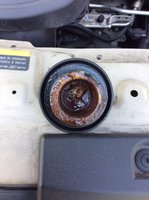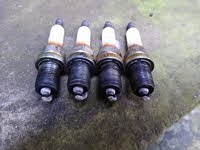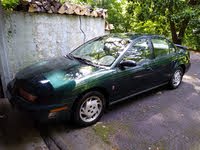Replace head gasket or not?
Asked by John Feb 18, 2013 at 08:11 AM about the 2002 Saturn S-Series 4 Dr SL Sedan
Question type: Maintenance & Repair
My 2002 Saturn SL has 108000 miles. I have owned it since it was new. I have had to replace a front spring and tie rod (on the same side) within the past year. I am now told it has a small head gasket leak. The car has been serviced according to the book (probably more). My choice is to add oil or replace gasket to the tune of $1200. Since the car is only worth $1400. I would like to fix it but people are telling me that it is not worth it. Please help
19 Answers
Is your oil a chocolate/milky color on the dipstick and over full? IF so, it's not a small head gasket leak, it's big and "big" can mean an opening the size of a pencil lead and IF it is in fact a blown head gasket it will only get worse real fast ..does it over heat John?
Better answer than mine Tom. By far
Like David said, check for the chocolate milkshake on your dipstick and in the coolant bottle. A percentage of heads on these cars have a casting defect and develop a crack in the head, leaking coolant into the oil. But from your suggestive answer to "add oil" Im assuming that the problem is primarily oil burning, in which there is no cure for(save rebuilding the bottom end). Let us know which of the 2 problems youre having.
Thank you for your suggestions Alex. I have driven about 150 miles since the oil change. The oil is nice and clean (no milkshake). There are spots in the driveway and my parking space at work. Is it worth have the "bottom end" rebuilt or should I just add the oil. I never mentioned that I only drive this car about 6000 miles per year now. It would more cost effective to add the oil but way less green. I am thinking that by rebuilding the "bottom end" that the top end (if there is such a thing) may need rebuild sooner than later.
Just run the car if youre not driving it that much. These motors are notorious for burning oil if you dont change the oil religiously every 3000 miles. The problem is that the pistons in these motors do not have oil drain back holes to allow oil to fall back down into the bottom of the engine. There are only 2 little reliefs on each side of the piston to let oil fall back down. As a consequence, the dirty grimy oil will gum up and make the oil control rings get stuck, therefore allowing the oil on the cylinder walls to get burned up during combustion instead of getting scraped off by the rings.
In short, its not worth the trouble and cost of rebuilding the engine. That is the only "defect" of these motors. You could try the Marvel Mystery Oil piston soak to try and loosen up the gunk around the rings, but thats up to you. Most Saturns will burn a quart of oil every 500- 1000 miles. Even more if the rings are stuck pretty bad. Just keep checking your oil levels every couple hundred miles and add the necessary amount and it'll run forever.
Something to check on also is your PCV on your valve cover is that valve is stuck it will build up pressure causing the oil in the top of your engine to either find a weak spot in your valve cover causing a leak or going down your valve guides and burning in the cylinder causing your car to use more oil I have a 2000 Saturn SL1 with 165,000 and it uses about 1/2 quart every 3000 miles / per oil change. So it's worth checking out the PCV pull it off the rubber hose and shake it it should rattle or just replace it about 8.00 dollars or so. Thanks
Thank you. I had the oil changed today (B4, I got your Email) It had been 3000 miles and In my opinion only trace oil was lost. In High School I had a 68 Chevy Bel Air that went through a quart every 100 miles or so. I will check out the PCV valve tomorrow just for the why not of it. I appreciate that you took the time to answer.
I have a 96 Saturn SC1, it's main running hot, I check the coolant system and it's a milky thickness coming out of the coolant bottle. I'm burning a lot of oil. From my understanding it make be a blown head gasket, I can't afford a replace gasket at the shop for 1200.00, how can I fix this problem or go buy used head gasket for this car.
hi does anyone know if I can use a head gasket sealer in my Saturn sl2 everyone here say I can not but is there something on the market that I can use? I am 70 yrs old woman doing this myself please help if you can Thank you Shiela
You can get it done cheaper. I'm needing the exact same thing for my Saturn. I purchased her. She had 71,000 miles on her. I love her because she is a manual drive. I racked an additional 62,000 miles since I purchased her. I had her flushed out but now I have no heat so I have to get the gasket replaced. Its gonna cost me $475. So call around and also ASK AROUND. people know GOOD MECHANICS that work from their garage (how I got my referral). The only draw back is that they perform the work ON THEIR TIME SCHEDULE. So she won't be ready for me until a week from now. Oh well. for $475 who's complaining???
Blown head gasket 2009 Saturn vue Benin putting coolent in allot but not leaking on ground email me tdrees2007@verizon.net
showcaseautosinc answered 9 years ago
YOUR FIRST PROBLEM WAS WHEN YOU BOUGHT A SATURN.. IT HAS 7 DIFFERENT CAR MANUFACTURERS PARTS IN IT. MECHANICS REFUSE TO WORK ON THEM IF THEY CAN. WHEN IT STARTED ,GM SAID IT WAS GOING TO BE A DIFFRENT CAR COMPANY, BOY ..THEY WERENT KIDDING.. I HAVE SOLD CARS FOR 52 YEARS, I OWNED ONE, AND IT WAS THE LAST ONE EVER !!! I WOULD'NT DO THAT TO ANY OF MY CUSTOMERS., HELL I WOULD;NT SELL ONE TO MY WORST ENEMY... GOOD LUCK...
That last answer is nonsense on several levels. A 2002 Saturn S Series does NOT have "7 DIFFERENT CAR MANUFACTURERS PARTS IN IT", quite the opposite. Where do people get such misinformation, and why do they spread it? During the time the S Series was made ('90 - '02), Saturn was a subsidiary of GM, not a division. In other words, unlike the divisions of GM, it was basically an independent company within a company. The S Series was completely proprietary and did not share anything with any division of GM, let alone "other manufacturers". In fact, that was one of the reasons the other divisions of GM complained so much about Saturn before 2003. Saturn had much more freedom than the divisions, which had to share and compromise with each other. However, S Series production ended with the 2002 models, Saturn had to start sharing, and every Saturn model other than the S Series was either just a half Saturn (the Ion and first gen Vue) or a Saturn in name only (a slightly disguised GM of Europe model with Saturn badges stuck on it) as Saturn became just another division of GM (2003 - 2009). The "real" Saturns (the S Series cars) have an excellent reputation for durability and quite a cult following, and there are still tons of them on the road 14 years after the last one was built. I've had four, and still have two that are doing great. As for your head gasket leak, it depends on where it is leaking. As has been pointed out, if coolant is getting into the oil or vice versa (milkshake) there's no getting around redoing the gasket or retiring the car altogether. If the coolant and oil are staying uncontaminated, many times a minor head gasket leak is no issue at all. For example, the Saturn dealer told me in 2006 (and 120,000 miles) that my 1995 SL2 has a "bad" head gasket even though it was showing no symptoms in performance or contaminated oil or coolant. I told them I'd keep an eye on it, which I have, and 10 years and 70,000 miles later it's still fine (at 190,000 miles). No symptoms at all, the coolant and oil are uncontaminated, and it still runs like a new car. So yeah, not all "bad" head gaskets are necessarily something that has to be addressed.
I bought my 1997 Saturn SW2 brand new 20 years ago in Sept 1996 as a factory order. Saturn's are basically junk. They had a lot of potential but they were designed as a throw-away car. My shift cable broke for the 2nd time recently and it was a real PITA to replace. I replaced the head gasket 2.5 years ago and it came out good but leaks oil from the "oil port" passenger side where the alternator attaches. I will seal that section with epoxy. It has always leaked from that spot since about 20K miles. Poor design. Other bad designs: motor burns oil and has since day one even with 3K oil changes. It is more than the pistons lacking drain back holes - how would that explain leaks on a new engine that hasn't had time to clog? Shifter cable - cheap and know for breaking.Alternator - why place it near the back bottom of the motor? PS pump also leak since new. Front crank seal leaked after about 25K. Transmission input shaft seal - leaked from day one and ruined one of my clutches by soaking it with oil. Want to replace the transmission input seal? You have to take all the gears out. Want to swap the transmission? You have to remove the motor! Oil filter - leak oil all over the CV axle which then spins it everywhere. Fuel filter is hard to change located in a weird place. Batter hold down is a stupid hard to change design that take 30 min! Transmission is cheap and is the worst shifting manual I ever drove. Guess how much I paid? $17,500 OTD with tax... 20 years ago!! and that is without power windows and Automatic transmission that would have been an additional $1700 or almost $19,200 20 years ago! In today's dollars about $30,000! The reason is Saturn did not have options packages - ever item was priced separately. For example, ABS $700, Station Wagon $700, Stereo with cassette and better speakers $350, AC $1000, SW2 vs SW1 $1000, The experiment called Saturn was a total failure and consumer rip-off.
spokanemobileauto answered 7 years ago
Saturns are not bad cars. You can get descent parts for them. The head gaskets on these cars do not "blow". They have an MLS (MULTI LAYER STEEL) design head gasket commonly found on most modern engine designs that use BI METAL (Aluminum head/Iron block) design. Over time, and with the numerous heating cycles, they expand and contract and eventually devolop internal leakage allowing the engine to suck in oil and burn it, and also allows exhaust gasses to enter the motor. Compression tests will not always show a leaking MLS gasket, but other simple tests will such as looking into the plastic overflow tank for AIR BUBBLES, CARBON BUILD UP, and exhaust gases. The tail pipe may show signs of wet carbon residue around the tip. MLS head gaskets are problematic, I dont like them. Very rarely, they will display the classic signs such as milky oil but it can happen in about 20-30% of cars on the road today depending on engine design. As a rule of thumb, i pretty much expect to see an MLS failure between 100,000 miles and 179,000k. Some cars factory gaskets can even see 250k before they totally go out...but the usual cases are commonly seen at around 100k-179k on any import or domestic vehicle. I use COPPER COATING on all headgaskets, wether the directions say so or not. DO IT!! It promotes heat transfer, eliminates hot spots, and provides extra sealing. Head gaskets rely on a specified machine finish on the blocks to seal up. Its simular to sand paper ratings from fine to coarse. After removing the original head gasket, this finish may be altered, since most guys doing head gasket repairs do not remachine the deck surface, COPPER COATING applied to the head gasket is a great and almost surefire way to make a head gasket seal the first time, for a long time.
If you have a Saturn, you know (out of production). That said, when a problem occurs w/any vehicle for that matter. It always prudent to work on whole system. I had leaking radiator,so I replaced it, thermos, hoses,etc. And now to poor power, OBD code of missing,etc. I am taking off fuel inj.,throd. body,intake manifold,etc. And using brake cleaner to clean the oil slug and carbon off parts. Person can find good prices on Ebay, paid approx. $125 for cooling,and $200 for intake parts for injectors were $80. Good luck, my shade tree macs!!!
A lot of BS on this thread from Saturn haters who are either poseurs or morons. To the guy with the lemon, did you ever consider that you got a "Monday AM vehicle" and complain to Saturn? Just curious. Thankfully, I did NOT get a Monday vehicle as my 1996 SL2 rips like a champ at over 200,000 miles and almost 25 years old. Wait until you see the pics I will post at the end!! I bought my hunter green baby with 25,000 miles for $9300 in 1998 and traveled 125,000 miles before ANYTHING need replacing besides tires, brakes and battery. I started getting a chatter on the clutch and decided to change it myself. Cost me $85 and two days to do (engine in the car). After that, I started having typical failures such as water pump weeping, radiator crack, AC needing R-134A, alternator failed load test and muffler rotted out. All these were fixed easily by me with used parts from Pull-A-Part or new parts from Rock Auto.com When you divide my car cost and maintenance by my mileage, I am OPERATING THIS CAR for 8 cents a mile not including gas and insurance. Oh, I was at Pull-A-Part one day and saw a CD player with amp and upgraded speakers in a 2002 Saturn. Popped right into my car and cost only $30. It's nice having an older car so long as it's reliable!!!! Speaking of reliable, I just took it from TN to MA and back for 2,500 miles round trip and it got 36 mpg with not one problem. AC running the whole way cuz I'm a polar bear at heart. LOL! This is my DAILY DRIVER at 24 years old and I will take this baby anywhere! Not selling until I take her to 300,000 baby!
Here is my 1996 SL2 from the post immediately above. The body is virtually mint with the exception of clearcoat peel from sun damage.




